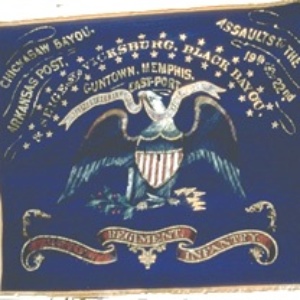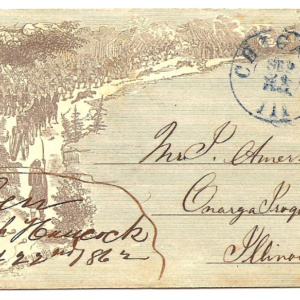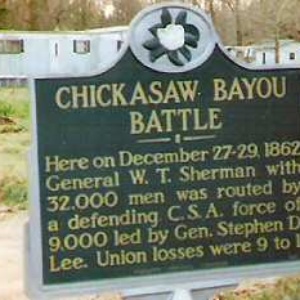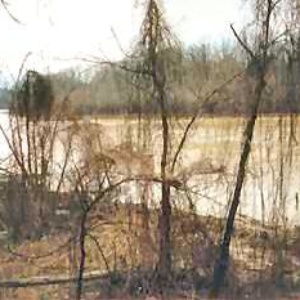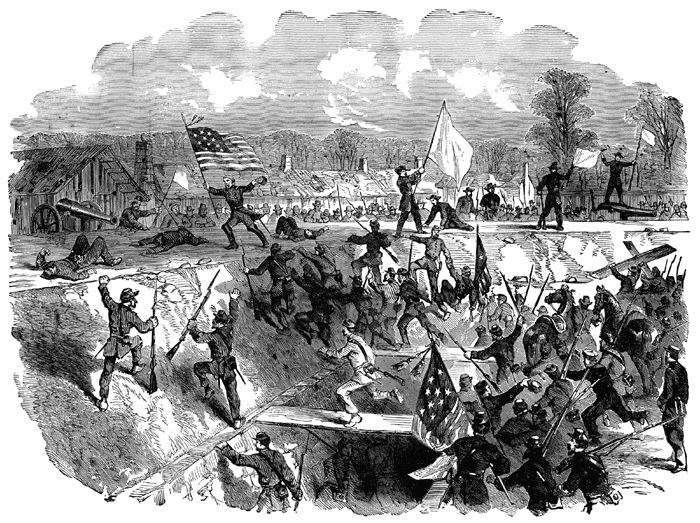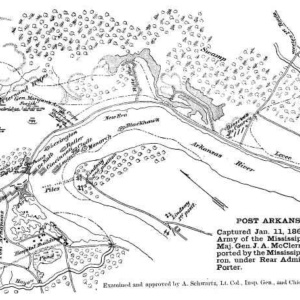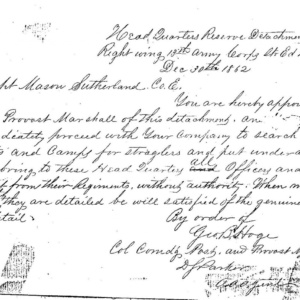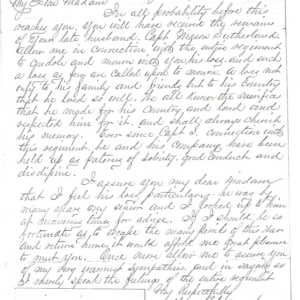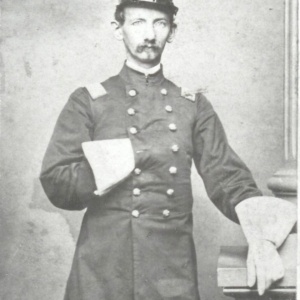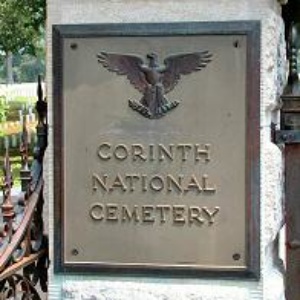Civil War
Northern Illinois actively opposed slavery and defended the Union during the Civil War. The local young men marched bravely off to war and an uncertain future. They fought battles and suffered disease. The soldiers gave their lives at Vicksburg and Brice’s Crossroads in Mississippi. Some died in prisons like the one at Millen, Georgia. The war left such bitter memories that it was not memorialized for a generation.

The History of the 113th Illinois Volunteer Infantry
The authorization to form an infantry company to fight in the Civil War was sent to Mason Sutherland of Palatine by Allen C. Fuller, the adjutant general of the state of Illinois. It was dated July 29, 1862. It reads:
Sir: You are hereby authorized to enroll and report at Chicago an Infantry Company for Government service for three years, unless sooner discharged.
Said Company to consist of not less than eighty-three nor more than one hundred and one STRONG, ABLE-BODIED MEN, over eighteen and not above forty-five years of age, and to be reported at Camp within THIRTY DAYS FROM THIS DATE.
If not reported with minimum number within thirty days,the company will be liable to consolidation with others similarly situated, or the men, previous to muster into service, at the pleasure of the governor, discharged.
Company Officers will be appointed and commissioned by the Governor; the recommendations of the Company will be duly considered, but fitness for position will be the rule governing appointments.
You will keep me advised of your progress in recruiting; reporting every ten days the names of recruits actually enrolled, and state the time squads will move to Camp, and transportation with marching orders will be promptly forwarded.
The Palatine Centennial Book reports that a meeting was held in the Methodist Church, at Wood St. and Plum Grove Rd., on August 11, 1862. Co. E, 113th Regiment of Illinois Infantry was born. Judge James Bradwell, whose family was prominent in Palatine, had helped to organize the company, and so it became known as the Bradwell Guard. A window in the Methodist Church commemorated the organization of the company. Men from Palatine Township, and Barrington, as well as a few from outlying areas such as Ela, Lake Zurich, and Elgin made up the company. Governor Richard Yates commissioned Mason Sutherland captain of Co. E in October. The Centennial Book tells us that when the company left for Chicago, “Nearly all the surrounding territory turned out to bid them farewell. Their captain… was presented with a sword, the gift of the Palatine ladies.” Co. E reported to Camp Hancock (near Camp Douglas) in Chicago.
- 113th Regimental Flag
- Civil War Window
- Camp Hancock 1862
Company E Answers Battle Call
Pioneer Press staff writer Robert Loerzel’s article, “Company E Answers Battle Call,” tells us that not all soldiers went to Chicago with Co. E.
Some of them were ill, [typhoid fever] and had to remain behind. They planned to join their fellow troops later on when they got better, but a few of them never made it out of Palatine and Barrington. The other soldiers stayed in the Chicago area until November, guarding rebel prisoners and drilling in preparation for battle….
In November, fever was still sweeping through Palatine Township, keeping some of the young men from joining their fellow Union soldiers in Tennessee. Twenty-three year old Josiah Blood died of typhoid fever on November 15, 1862.
Co. E was mustered into service on November 6, 1862, when they left Camp Hancock for Memphis, Tennessee, and Camp Peabody. On November 21st, Mason Sutherland received the following orders from the Headquarters of the 113th Regt., Illinois Volunteers:
Capt M. Sutherland
You are hereby detailed with such men as you may select to forage on the enemy and bring to camp such articles as may be needed by your company or its Regt.
By order of
Geo B Hoge Col., Comdg.
The regiment left Memphis with General William T. Sherman for Oxford, Mississippi, to participate in the Tallahatchie Expedition, part of General Ulysses S. Grant’s Northern Mississippi campaign. It returned to Memphis on December 8, 1862, and remained there until December 24th. The 113th then moved down the Mississippi River with General Sherman to Vicksburg. It was brigaded as the First Brigade, Second Division; General Morgan Smith, division commander and Colonel Giles Smith, brigade commander.
From December 26th to the 28th, the regiment participated in the battle of Chickasaw Bayou. The Pioneer Press article says of this battle:
Historian Victor Hicken wrote that the battle was hastily planned and disorganized, not a bright moment for Sherman. The three-day movement ended in defeat, and when Sherman retreated, the regiment was turned over to the hands of Gen. John A. McClernand.
Mason Sutherland received the following orders on December 30th.
Head Quarters Reserve Detachment, Right Wing 13th Army Corps, Dec. 30th, 1862
Capt Mason Sutherland Co. E.
You are hereby appointed asst Provost Marshall of this detachment, and … will immediately proceed with your company to search all Boats and Camps for stragglers and put under arrest and bring to these Headquarters all Officers and soldiers absent from their Regiments without authority. When men claim they are detailed be well satisfied of the genuineness of the detail.
By order of
Geo. B Hoge Col Comdg Post and Provost Marshall
Next, the 113th Illinois Infantry went with the army to Arkansas Post and took part in its capture on January 11, 1863. The regiment lost heavily, Loerzel tells us:
The regiment “behaved with great gallantry in the face of a destructive fire from the enemy’s rifle-pits at a short range, and suffered a considerable loss in consequence,” wrote Alex Whitehall, a captain for the Union army and a Civil War historian.
Colonel Giles Smith filed the following report after the battle of Arkansas Post.
HDQRS. FIRST BRIG., SECOND DIV., 15TH ARMY CORPS,
Arkansas Post, Ark.,
January 12, 1863
Captain: I have the honor to submit the following report of the part taken by the First Brigade, Second Division, Fifteenth Army Corps, in the battle of Arkansas Post, on Saturday and Sunday, January 10 and 11 instant:
At 1 o’clock on Saturday, the gunboats having driven the enemy from their first line of intrenchments, under orders from General Stuart to advance the First Brigade, with one regiment deployed as skirmishers, up the river, the left resting on it until we drew a heavy fore from the enemy, I deployed the Eighth Missouri as skirmishers, Lieutenant-Colonel Coleman commanding, and moved forward. The skirmishers had advanced but a short distance into the woods beyond the evacuated works when they met the enemy’s skirmishers, who were steadily driven back into their second line of rifle-pits. Our skirmishers, advancing from tree to tree, soon drove them from their works, which were taken possession of, and an immediate advance ordered, driving them into their main fort. Under its guns the brigade was halted, awaiting the arrival of more troops. Our skirmishers were thrown around to the right, encircling their works for more than half a mile, three companies of the Sixth Missouri being deployed on the right to complete the line. This ground I was ordered to hold until the arrival of the columns, which occupied the rest of the day.
At daylight on Sunday morning I was ordered by General Stuart to move around to the right and occupy an open field, about 1,000 yards from the enemy’s interelements and above the fort. Companies A and B, First Illinois Artillery, commanded respectively by Captains Wood and Barred, took position on our right and left and did good execution throughout the day, moving up on our left after our advance and assisting greatly in keeping down the enemy’s fire.
After a heavy cannonading of about half an hour from our batteries and the gunboats, orders were received for the whole line to advance and assault the works. The First Brigade moved in the following order: The Sixth Missouri on the right, the One hundred and thirteenth Illinois on the left, the One hundred and sixteenth Illinois in the center, and the Eighth Missouri and Thirteenth U.S. Infantry in reserve. On arriving within range of musketry we were opened upon not only by the whole line in front, but by an enfilading fire from the right from three field pieces, and from both right and left from musketry. The columns that were to have come up on both right and left having failed to arrive, while awaiting their advance I ordered sharpshooters to advance to check as much as possible the enemy’s fire, and I sent back a messenger to General Stuart Describing my position.
At 4 o’clock no support had arrived. I now deployed the Eighth Missouri on the right, who were soon supported by the Fifty-seventh Ohio sent by General Stuart from the Second Brigade, and ordered the Sixth and Eighth Missouri to advance until they could silence the three field pieces by sharpshooting. They advanced to within 100 yards of the guns, which they effectually silenced, not only picking off every gunner who showed himself above the works, but killing every horse belonging to the battery.
My whole line was now within 150 yards of their works, the men being only partially covered by scattered stumps and logs. The Second Brigade, Col. Kilby Smith commanding, now took position on my left, when the whole line advanced; but before reaching their intrenchments white flags were displayed, the firing ordered to cease, and the entire force of the enemy surrendered themselves prisoners of war….
The conduct of both officers and men of my command justly merits the highest praise. Not one inch of ground gained was given up, and all orders to advance promptly obeyed.
Lieutenant-Colonels Blood, commanding Sixth Missouri, and Coleman, commanding Eighth Missouri, and Chase, commanding first battalion, Thirteenth U. S. Infantry; Colonel Hoge, commanding One hundred and thirteenth Illinois; Lieutenant-Colonels Paddock, One hundred and thirteenth Illinois, and Boyd, commanding One hundred and sixteenth Illinois, and Major Froman, One hundred and sixteenth Illinois, displayed great gallantry in gaining and holding their positions in so short musket-range of an intrenched enemy.
- Location of Battle Site
- Chickasaw Bayou
This being the first time the One hundred and thirteenth and One hundred and sixteenth Illinois were ever under fire they sustained themselves nobly throughout the entire engagement. The Fifty-seventh Ohio, Colonel Mungen commanding, assisted by Lieutenant-Colonel Rice, sent to support our right, were also in the hottest of the fire, and behaved like veterans.
Of my personal staff, Lieut. D. S. Parker, One hundred and thirteenth Illinois, acting assistant adjutant-general, who was severely wounded by a Minie ball in the leg, and Lieut. Nelson Patterson, Eighth Missouri, aide-de-camp, rendered most efficient aid in conveying my orders to every part of the field….
Giles A. Smith
Colonel Eighth Missouri, Commanding First Brigade.
After the battle of Arkansas Post, Companies C, D, F, I, and K were sent north with prisoners of war. They remained at Springfield and did not rejoin the command until 1864.
The other five companies, including Company E, went to Young’s Point, Louisiana, where they acted as provost guard for General Sherman’s 15th Army Corps. Robert Loerzel tells us of their stay there.
Historian Bruce Catton described this period as the “Valley Forge” of the Civil War, when soldiers hit their low point of depression, “the winter of misery and despair, of cold and hunger.” Young’s Point was a miserable place to be during these dark months. “The place will long be remembered with horror by those who survived, and who helped with trembling hands and aching hearts to place under the sod of this fated point so many of their dead comrades, Whitehall wrote.
The commanding officer of Company E, Capt. Mason Sutherland of Palatine, had typhoid fever in January, and the regiment’s surgeon wrote a letter to the medical director describing Sutherland’s condition:
“This is to certify that Capt. M. Sutherland has been ill over two weeks with a depraved state of the secretions, a torpid condition of the liver and general debility. He requests the privilege of being sent to the hospital in Memphis. It is my opinion that he will not live one week if he remains here.” [Permission was given, but it was too late.]
Sutherland died at Young’s Point on Jan. 27 [1863].
A while later, some soldiers from Palatine were traveling south to join up with their comrades at Young’s Point. They encountered a coffin traveling north in the town of Cairo, Ill. It was the body of the man they had expected to command their company: Mason Sutherland.
Captain Charles Trumbull later took charge of the company.
In March of 1863, the 113th assisted General Sherman in the rescue of Admiral Porter. The admiral, with six gunboats, had gone through Steele’s Bayou to Black Bayou and up Deer Creek. There, slowed by obstructions in the water, he was surrounded by the enemy. The troops went as far as possible by steamship. With General Sherman commanding, in person, they made a forced march of twenty five miles on foot. No horses could be used as the terrain was marshy. They often had to walk single file and traverse makeshift bridges. After reaching the gunboats, the enemy was driven back into the woods and the gunboats were freed. The next day they began the return march, reaching camp after a ten day absence. Details of this expedition are given in the following military reports.
Headquarters Fifteenth Army Corps
March 29, 1863
Sir: I had the honor to report to you the result of my observations on the projected route to the Yazoo, by way of Steele’s Bayou, up to the 21st of March. On that day I was at Hill’s plantation, on Deer Creek, where Black Bayou enters it….
At that time the admiral had advanced up Deer Creek with five ironclads, but before reaching Rolling Fork had found the creek so full of growing trees and willows that his progress was slower than he had calculated, and the enemy had begun further to obstruct his progress by felling trees in the channel and firing from ambush on his working parties when exposed on the decks or on the banks of the stream. I had, at his call, sent forward every man then with me, and had put in motion all my steamboats to bring forward more troops from Eagle Bend.
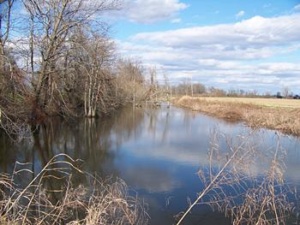
By night three steamboat loads had arrived at the foot of Black Bayou, and were transferred to the visible ground above water, at a point on the south shore of Black Bayou, about one and one half miles from its mouth and two and one half miles from Hill’s plantation. I conducted them through the dense canebrake, by lighted candles, up to the plantation that night, and on the next morning (March 22), without means of transportation… we marched over the same road that had been traveled by Colonel Smith.
These troops were the battalion of the Thirteenth Regulars and the One hundred and thirteenth Illinois Infantry, being the remainder of Col. Giles A. Smith’s brigade, and the Eighty-third Indiana, One hundred and sixteenth Illinois, Fifty-fourth and Fifty-seventh Ohio….
Our arrival was very opportune, and the two leading battalions pushed the enemy along the swamp in rear of the plantation fields that bordered Deer Creek for about 2 miles, and until they were to the north and rear of the gunboat fleet. In person I pushed along the bayou road till I met Colonel Smith coming down to interpose between this same party and his outlying detachment. As soon as possible I communicated with the admiral, and learned that he had found the route far more difficult than he had been given to believe, and owing to natural and artificial obstacles to his advance, he had abandoned the attempt to reach the Yazoo, and at the time of my meeting him was in the act of backing down Deer Creek. I accordingly made the necessary dispositions to cover his boats while engaged in this slow and tedious process.
The progress was slow, consuming all of the 22d, 23d, and part of the 24th of March, when the fleet again reached Black Bayou, at Hill’s plantation. Not a shot was fired at the gunboats after we drove the enemy back on first encountering him. The enemy hung upon the rear of our column, but would not come within reach….
I inclose [sic] the report of Col. Giles A. Smith and Lieutenant-Colonel Rice, and being myself along, bear testimony to the alacrity of the troops, their eagerness to pursue the enemy, and the cheerfulness with which they marched in rain and mud. I feel assured Admiral Porter will admit we rendered him and his fleet good service, as without our presence it would have cost him many valuable lives to have extricated his boats while the banks of Deer Creek were lined by the enemy’s sharpshooters, against whom his heavy ordnance could not well be brought to bear….
I am, very respectfully, your obedient servant,
W. T. Sherman, Major-General, Commanding Fifteenth Army Corps
Remained at Milliken’s Bend some two or three weeks, and then started, with General Sherman, on the march to the rear of Vicksburg. Arrived there on the evening of the 18th, and participated in the assault of the 19th and 22d, in which the Regiment lost heavily. Colonel Hoge being wounded, on the peremptory order of the Corps Surgeon, he received leave of absence. Shortly after his departure, the Battalion was detailed on provost duty on Chickasaw Bayou, an exceedingly unhealthy place. The result was, that in a short time, almost every officer and man was on the sick list. Major Clark then got an order to proceed to Springfield, Illinois, and take command of five companies there, where he remained till he joined the Battalion, with his command, in Memphis, Tennessee late in the fall of 1864.
The Pioneer Press article tells us more about this campaign.
” …the Bradwell Guard joined in one of the Civil War’s most famous and longest battles, the Siege of Vicksburg. They marched south along the west side of the Mississippi River, leaving during a rainy night and hearing the eerie noise of bellowing alligators in nearby swamps, according to Catton. The troops crossed the mighty river, then swung north to the rear side of Vicksburg. The actual siege of the city began May 18 and lasted until July 4.
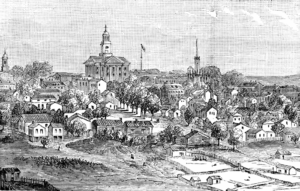
“In this campaign, the 113th suffered from both disease and the bullets of the enemy, losing fully one entire third of the force that went into the campaign,” Whitehall wrote. Pvt. Charles C. Rogers, of Palatine, died of a wound June 1 at Vicksburg.
Shortly after the fall of Vicksburg, Companies A, B, E, G and H, were ordered to Corinth, Mississippi, and, on October 1, 1863, Colonel Hoge was placed in command of that post and remained in command till the evacuation, which was on the 25th of January 1864. From there, was ordered to Memphis, and brigaded with the Second Brigade, Post and Defenses of Memphis, Colonel Hoge commanding.
Three Palatine men died at Corinth in September of 1863. They were Pvt. Arad Cady and Cpl. Nathaniel Sayles, who both died of chronic diarrhea. Private Diedrick Grote’s death was attributed to chronic inflammation of the brain.
On the 12th of January 1864, Colonel Hoge was ordered to take command of the following named Regiments and Batteries: Eighty-second Illinois, Ninety-fifth Illinois, One Hundred and Eighth Illinois, One Hundred and Thirteenth Illinois, One Hundred and Twentieth, and Company B, Second Illinois Light Artillery-and join General Sturgis, in his expedition against Forrest.
The disastrous results are related by Robert Loerzel.
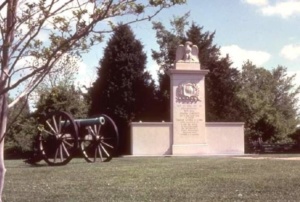
“On June 1, the soldiers set out from Memphis along with perhaps as many as 12,000 other troops, heading toward Tupelo, Miss., under the command of Gen. Samuel D. Sturgis. Their mission was to go after Confederate Gen. Nathan Bedford Forrest. Alex Whitehall, a captain for the Union army and Civil War historian, described Forrest as “the daring rebel raider, and cruel butcherer of unoffending and helpless prisoners.”
In his writings, Whitehall painted a grim picture of the days leading up to the battle. “The sultry weather and heavy rains made the marching laborious and slow, and exhausted the whole command so much that they were in a poor condition for a pitched battle when the terrible blow fell upon them,” Whitehall wrote…. ” The tired troops marched through mud and rain until the morning of June 10, when the sun burst out shining. Instead of putting his troops into a strong assaulting column, and moving forward cautiously, Gen. Sturgis made his soldiers hurry up, forcing them to run several miles in the hot sun. Whitehall wrote. The soldiers “were pushed forward singly and without any apparent order against the enemy lying in his strong position, only to be ruthlessly cut down by a well-directed fire from the ranks of Forrest. The soldiers went into the fight “exhausted and panting with the fatigue of their long run to the battlefield, and were pushed forward in the face of a murderous fore from a foe strongly posted under cover,” he wrote.
As the Union troops retreated, night fell upon them, causing their panic to deepen. Their wagon train became stuck in mud, making it impossible for the soldiers to take all their artillery with them. Luckily, the cavalry held back Forrest’s “triumphant and plundering troopers,” allowing many of the Union soldiers to escape. “Many actually marched a hundred miles before tasting food,” Whitehall wrote. “The whole command, or what was left of it, reached Memphis half starved, footsore and completely exhausted, and bitterly cursing the heartless and stupid conduct of Gen. Sturgis.”
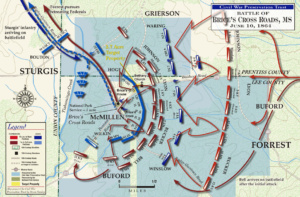
According to Whitehall, Sturgis fled the battlefield at the first sign there was going to be a rout and had reached Memphis safe and sound. Whitehall wrote, “Gen. Sturgis may have been a good soldier and a patriot, but it will be long before the men he led into that fatal trap will be willing to regard him as such.”
More than 2,000 Union soldiers were injured or killed on the battlefield at Guntown, Mississippi.
Two men from Palatine were taken prisoner of war in this battle. According to the Company E muster roll, Pvt. Arthur Davis was “last heard from at Andersonville, Ga., Sept./ 64. …Supposed to be dead.” Pvt. Louis Bergmann’s entry says, “Died Oct. 29/64 in Rebel prison at Millen, Ga.”
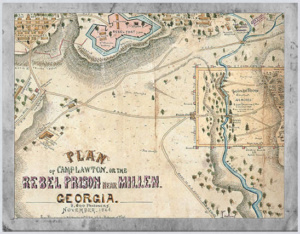
Following is the report that Colonel Hoge made after the battle.
HDQRS. SECOND BRIGADE, DISTRICT OF MEMPHIS,
Memphis, Tenn., June 14, 1864
Lieutenant: I have the honor to submit the following report of the part taken by the Second Brigade, under my command, in the late expedition into Northern Mississippi, which was conducted by Brigadier-General Sturgis:
In accordance with Special Orders, No. 38, paragraph 19, headquarters District of West Tennessee, dated May 31, 1864, I reported my command at 2 p.m. of the next day at the depot of the Memphis and Charleston Railroad, prepared for embarkation. Having reported at the appointed time and place with my command, two additional regiments of infantry and one battery of light artillery were assigned to me, and the Second Brigade consisted then and throughout the expedition of the Eighty-first, Ninety-fifth, One hundred and eighth, One hundred and thirteenth, and One hundred and twentieth Regiments of Illinois Infantry and Company B, Second Regiment Illinois Artillery, commanded by Capt. F. H. Chapman.
At 6:30 p.m. of Wednesday, 1st instant, the entire command had embarked on rail cars, and the train immediately moved away from the depot, and at 9 p.m. arrived at a point about half way between Collierville and La Fayette, Tenn., where the command disembarked and bivouacked for the night, near the railroad track, in the woods.
Reveille was sounded at 4:30 o’clock on the ensuing morning, Thursday, the 2d, and the brigade marched at 6 o’clock, by land, toward La Fayette, where, about 11 a.m., the First and Third Brigades were found encamped. I passed on beyond La Fayette one mile and went into camp.
On the following morning, Friday, the 3d, the entire column of infantry was in motion at 3:30 a.m., the Second Brigade having position in the center. Arrived at night at Lamar, Miss., a small station on the Mississippi Central Railroad, and halted on a high and commanding position near the same. About 11 a.m. a heavy and continuous rain set, which only ceased late in the morning of Saturday, the 4th. The command resumed the march at 11 a.m., the Second Brigade in front, and marching toward Salem. The day was fine, the roads improving, and the troops in good spirits. At 5 p.m., the column arrived at Robinson’s plantation (about half way to Salem), and bivouacked in fine location near the same.
Sunday, the 5th, the march was resumed toward Salem at 6 a.m., and continued until noon, when the command halted for the day about a mile beyond Salem. The weather was clear and fine, but very warm.
About 4 a.m. of Monday, the 6th, the column was again in motion, the Second Brigade in the rear, and the One hundred and thirteenth Regiment Illinois Infantry in charge of the division supply and ammunition train. When about ten miles from Salem, the train was fired upon by a small party, who inflicted no injuries whatever. A severe rain, with a good deal of thunder and lightning, prevailed about three hours during the day, which so impaired the roads as seriously to delay the troops and train. The weather soon after changed for the better, and at night the column halted at a point fourteen miles distant from Ripley. The march was resumed toward Ripley at 10 o’clock, through a hilly, thickly-wooded, and thinly-settled country. Forage became scarce, and all the stock suffered. At 4 p.m. the command arrived within four miles of Ripley, and the Second and Third Brigades halted on the plantation of Mr. Crowder, while the First Brigade pushed forward to join Grierson’s cavalry at Ripley. The weather was warm and sultry, but there was no rain.
About 4 o’clock on the morning of the 8th I resumed march and passed through and about two miles beyond Ripley and halted for two hours, when I was ordered to return, and about a mile back took the road leading to Baldwyn, on the Mobile and Ohio Railroad. The column halted on this road about four miles from Ripley.
At 10 a.m. of the 9th march was resumed, my command having the center, and continued for twelve miles one the Ripley and Baldwyn road, where we were halted on a fine high ridge and bivouacked for the night.
The column moved at 10 o’clock of the 10th instant, my command in front. Much delay was occasioned by bad roads, but by special effort the artillery and wagon train was kept closed up on the marching column. About 1 p.m. I received an order from Colonel McMillen to move forward instantly, as General Grierson was fighting and hotly pressed. I moved at once. Shortly after Colonel McMillen sent me word that he would move forward with his escort at such a gait as he thought the infantry could march, but if I found that it was too much for them to send him word. I kept up the gait for about two miles and a half, when it was reported to me that five men had been sun-struck in the advance regiment of the brigade, the One hundred and thirteenth Illinois Infantry. I immediately sent Captain Woodruff forward to Colonel McMillen to say that it was impossible to keep up that rapid gait. I then halted for five minutes at a small stream for the men to fill their canteens, and then moved forward at a more moderate gait. Shortly afterward I received a peremptory order from Colonel McMillen to move forward as rapidly as possible, as the enemy were gaining ground, and the only thing that would save us was the infantry. I then increased the gait of the command, and kept up a quick march till within about three-quarters of a mile of the line of battle, when I received an order from Colonel McMillen in person to move forward at a double-quick which was done, which was done and kept up until I came to the line of battle, when I placed the One hundred and thirteenth Illinois Infantry with its left resting on the road crossing the Ripley and Baldwyn road; the One hundred and twentieth Illinois Infantry was placed with its left resting on the right of the One hundred and thirteenth, the One hundred and eighth Illinois Infantry with its left resting on the right of the One hundred and twentieth, the Ninety-fifth Illinois Infantry with its left resting on the right of the One hundred eighth, the Eighty-first Illinois Infantry with its left resting on the right of the Ninety-fifth, where a cavalry regiment rested on the right of the Eighty-first, and completed the line across to the Baldwyn road. Battery B, Second Illinois Artillery, Captain Chapman, four guns, were placed at the cross-roads, where they fired 5 and 3 second shell. Colonel McMillen ordered one gun to be run down the Baldwyn road about 400 yards, and being hotly pressed by the enemy, two of the horses being killed, the piece fell into the enemy’s hands along with two caissons. About this time the first line of battle gave way, but was reformed on the road, which we contested for some time, till our left flank was turned, when the command fell back in a hurried and disordered manner. This was kept up all night. The battery lost its three other guns and remaining caissons at the Hatchie Swamp, which was impossible to cross. The guns were all spiked before abandoning them, and the horses saved.
The last of the infantry reached Ripley about 7 a.m. Saturday, the 11th instant, closely pursued by the enemy, when my command was at once organized, and left Ripley in good order, following the First Brigade about 7:30 a.m., the enemy following close on our rear. At a distance of about three miles northwest of Ripley the enemy’s cavalry flanked the infantry which were marching in the rear of the cavalry, except one regiment of cavalry which was acting as a rear guard. My command, such as had guns, formed for defense with fixed bayonets, but many of them were captured, owing to their exhausted condition and lack of ammunition; many to escape capture and to hasten their retreat toward the main column, abandoned their guns and cartridge boxes. The retreat was continued by a route lying four miles to the right of Salem and seven miles to the left of La Grange toward Moscow, Tenn., on the Spring Hill road, continuing our retreat during the whole of Saturday night, and arriving at La Fayette, Tenn., at 4 a.m. of Sunday, the 12th instant, where the last firing of the enemy took place on our rear. The retreat had been through a hilly country, hard to travel, and the roads being very muddy and the men being without provisions, and keeping up with the cavalry reduced them to an exceedingly exhausted condition, and many fell unavoidably into the hands of the enemy.
The command reached Collierville, Tenn., about 10 a.m. of Sunday, and bivouacked there until the arrival of trains from Memphis, when they were transported to this city on board the cars.
The following figures show the original strength of the brigade and the number of killed, wounded, and missing, as compiled from reports made to this date, midday of the 14th instant. Stragglers and escaped prisoners are arriving within our lines in small numbers daily.
The number of guns brought in by the entire command is 267.
[The figures mentioned are given here only for the 113th Illinois Infantry.]
Original strength :
Field officers…………………………….1
Staff and line officers……………….12
Enlisted men…………………………293
Killed:
Field officers……………………………..
Staff and line officers………………..1
Enlisted men…………………………….4
Wounded, present and absent:
Staff and line officers………………….
Enlisted men…………………………..32
Missing:
Field officers……………………………..
Staff and line officers………………..6
Enlisted men………………………. 106
In conclusion, I would say that the officers and men of the entire command acted in the most gallant manner. I think especial notice is due to the officers and men of the One hundred and twentieth Illinois Infantry, it being the first time they have been under fire.
All of which is respectfully submitted.
I am, lieutenant, very respectfully, your obedient servant,
GEO. B. HOGE,
Colonel Commanding
Another relevant report was filed on the 113th’s role in this battle:
HEADQUARTERS 113TH REGIMENT ILLINOIS INFANTRY
Memphis, Tenn., June 15, 1864
Lieutenant: I have the honor to report that on the first day of June, 1864, I moved with a portion of my command, numbering 12 officers and 293 men, with the late expedition commanded by Brigadier-General Sturgis, by railroad to a point four miles beyond Collierville, Tenn., where I left the cars and went into camp for the night….
On the 9th instant twenty men were pronounced unfit for duty and were sent back to Memphis.
Came up with the enemy near Guntown, Miss., about 1:30 p.m. on the 10th instant. I was ordered to advance with my command at a double-quick to support the cavalry, which was then fighting. We doubled-quicked [sic] about four miles, and one-third of my men were so completely exhausted as to be scarce able to stand; several were sun-struck. Firing commenced as soon as we were in line of battle and was kept up with great rapidity for nearly half an hour, but our ammunition was nearly exhausted and we were being overpowered by superior numbers, so were reluctantly compelled to fall back, which we did in tolerably good order, fighting as we gave ground. We formed a new line and fought the enemy until our ammunition was entirely exhausted, when we were compelled to retreat, knowing it would be useless to contend against the odds of four to one. I am sorry to say that our retreat was in great confusion. We continued to fall back all night until we reached Ripley, Miss., where we halted and endeavored to collect our scattered forces, but before it was fully accomplished we were again attacked by the enemy’s cavalry, which had followed us during the night. Our men were fatigued, and many of them were without arms or rations, and were not in a condition to engage him, so we were again compelled to retreat. We were closely pursued by the enemy until we arrived within a few miles of Collierville. My rear skirmished with him almost the entire distance.
A portion of my command reached Memphis during the night of the 12th, others on the 13th instant. I am pleased to say that my whole command, both officers and men, behaved nobly; not a man flinched, although many of them were under fire for the first time, being recruits. Illinois soldiers always do their duty.
GEORGE R. CLARKE
Lieutenant-Colonel, Commanding
The 113th had not seen the last of General Forrest. He attacked Memphis on August 21, 1864. The regiment assisted in repulsing that attack. For the rest of the year it remained in Memphis on picket duty. In March of 1865, it formed part of an expedition to Eastport, Mississippi, on the Tennessee River. Once again they met up with a large force under General Forrest, which repulsed the Union forces. The command returned to Memphis. On March 23, 1865, Colonel Hoge was appointed Provost Marshal of the District of West Tennessee.
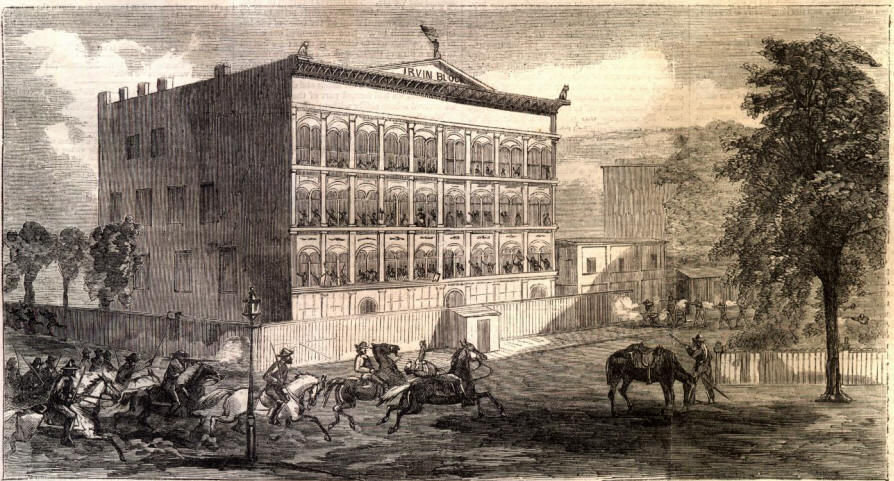
- Battle of Arkansas Post
- Map of the Site of the Battle of Arkansas Post
- Message to Capt. Mason Sutherland
- Letter to Nancy Sutherland
- Col. George Hoge
On June 20, 1865, the 113th Illinois Infantry was mustered out of service at Memphis, Tennessee. The regiment was ordered to Chicago, where it received final pay and was disbanded on June 25, 1865.
The regiment lost during service 1 officer and 25 enlisted men killed and mortally wounded and 4 officers and 273 enlisted men by disease. The total was 303.
To see a complete roster of Co. E., paste the following into the address bar of Google: https://civilwar.illinoisgenweb.org/r155/113-e-in.html
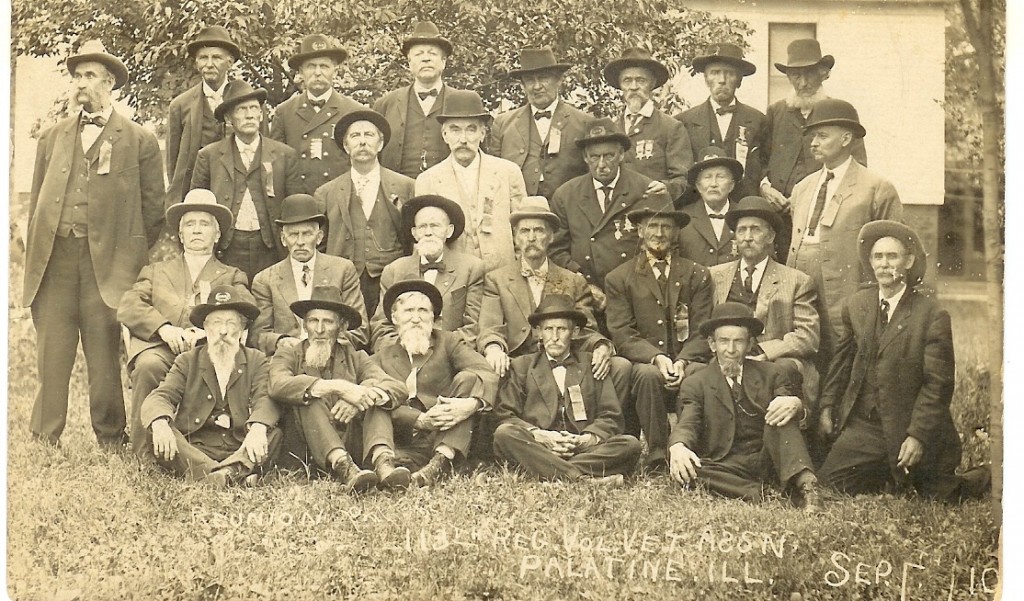
In August of 1862, a meeting was held at the Palatine Methodist Church by Judge James Bradwell and Mason Sutherland. The state of Illinois was mustering troops to fight in the Civil War and the two men had gotten permission to muster a company of soldiers. After talking to the men a muster roll was laid out and men were asked to enlist. After another meeting held in Barrington, there were enough men to form Company E of the 113th Illinois Volunteer Infantry. The men went to Camp Douglas in Chicago to train for the war.
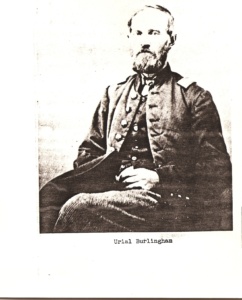
In October, Mason Sutherland was elected their captain. For three years these men fought, suffered illnesses, were disabled, died, or survived. Their experiences were like none these men had ever known and their camaraderie for each other would never die. The whole regiment, not just Company E, formed a veteran’s association and each summer they met in some city or town where members lived and expressed their friendship for each other and sympathy for those who were gone through church services, speeches, concerts, meals prepared by the ladies of the town, and yes, a few drinks. This photograph is from the 1903 reunion in Palatine. Some of these men were local veterans of other units but were welcomed into the activities. Some of these men are known by name. The man sitting on the ground with the hand of the man behind him on his shoulder is Charlie Fosket. His very good friend behind him was Anson Baldwin. To Fosket’s own left is August Kimmet who was not in the 113th but was a Palatine man and the last Civil War soldier to die here. To Fosket’s right is David Maloney from Co. F. The man directly behind Kimmet is Charles Robinson. The man seated in the second row to the very left is John Hamilton of Palatine. The man standing at the very left is Dr. H. B. Osborn of Co. G. To the Dr.’s left is Bert Webster. In the back row, second from the right is M. Umdenstock. Second to the right of him is Hiram Swick of Co. E.
Reunions of the 113th Illinois Infantry
Some time after the Civil War, the veterans of the 113th Regiment organized the 113th Illinois Volunteer Veteran Association. Yearly reunions were held in various towns and cities all over Illinois. The first reunion was held in 1885. Nothing is known about the early reunions. We do know that Anson R. Baldwin of Palatine was highly involved and served as an officer of the organization for many years. He attended many out of town reunions, and was most likely responsible for Palatine serving as the host for two of the reunions. The following reports were gleaned from the pages of the Palatine Enterprise, unless otherwise noted.
September, 1901
Anson Baldwin attended the 17th reunion of the 113th Volunteer Veteran Association in Shelby, [Sheldon] Illinois. The meetings were held in the YMCA building. About 50 men attended. Baldwin was elected secretary of the association. A resolution was passed to stamp out anarchy and copies were to be sent to all Illinois legislators. Secretary Baldwin was to send a resolution of sympathy to Mrs. McKinley. President McKinley had been assassinated.
September, 1903
The 19th reunion was held here in Palatine. A lengthy article appeared in the Enterprise.
Reunion of the 113th Illinois
Palatine was proud when the 113th Regiment of Illinois Veteran Volunteer Infantry Association chose this place to hold their nineteenth annual reunions. She did her best to make welcome the veterans of this – her home regiment. Sixty members of Co. E., with Capt. Sutherland at its head enlisted in the old M.E. Church under the name of the Bradwell guards. Mr. Bradwell was present and influenced in the enlistment, and 41 years later was present to greet the boys who are left. This regiment, one of the bravest and truest sent out by Illinois, was known as the “Third Board of Trade” regiment and was organized from Cook, Iroquois, Kankakee and Lake Counties. They left Chicago 840 strong and when the wives and sweethearts welcomed them back only 272 answered roll call. Over 200 were enlisted during the war, thus 800 were called upon to give up their lives for their country.
The W.R.C., of which we are justly proud, had in charge the entertainment of the visiting comrades, and the three rousing cheers given them by their guests at the camp fire was sufficient reward for their efforts. The color bearers of that society acted as the Reception Committee and the hearty handshakes form the young ladies as the veterans stepped off the trains made them feel that the small bronze button they wore was a key that unlocked every door and heart in Palatine. Across the way could be seen the sign “G.A.R. Headquarters” in large letters, each of which seemed to speak the word welcome. To these rooms the comrades were taken, where each signed the register, which holds the names for many reunions. The meeting of old friends was oftentimes pathetic. Many were the comical stories told of Libby, Andersonville, that march down the Mississippi, and of camp life.
John Fritch acted as President and first session was spent in registration, reading of the Secretary-Treasurer’s report, and short talks by several of the comrades. Chebanse was chosen as the place for the twentieth reunion. The Arlington Heights Fife and Drum Corps was present throughout the day and their martial music made many a soldier’s face light up with joy. Wednesday evening, the soldiers formed in line and headed by the Fife and Drum Corps, marched from their hall to the Methodist Church, where an elaborate supper had been prepared. Judge Bradwell told of the hardships in organizing Company E. Others gave short talks and this hour was one of the happiest during the reunion.
Woodman Hall was packed at the camp fire Wednesday night by citizens who came to make the blaze a large one that warmed the hearts of all. The Fife and Drum Corps gave several selections during the program that elicited praise from everyone. Following prayer the Rev. D.J. Holmes, Mayor A.R. Olms welcomed the G.A.R. to Palatine and in a few well chosen words extended to them the freedom of the city. Judge J.B. Bradwell responded, telling how the regiment was raised, their number and of their bravery. Selections by the quartette were appreciated, also a duet, “My Own United States” sung by Misses Elnora Arps and Emma Kuebler. Attorney R.L. Peck gave an interesting address on behalf of the citizens and was responded to by Dr. H.B. Osborne. Mrs. Nettie McGoven told of the W.R.C. and the audience was made familiar with its work. John C. White talked of the G.A.R.: How they stood ready to defend their country, and hoped the younger generation would guard it as well in the future. A.R. Baldwin gave reminiscences of the 113th regiment, telling of their march, etc., that was very interesting. The audience joined in singing “America,” and they departed with patriotism burning in their souls.
The association held its last meeting Thursday morning. The following officers were elected:
S.R. Duel, Chebanse, President
I. Pruett, Chebanse, First Vice-President.
T.S. Arnold, Watseka, Second Vice-President.
E. Mills, Kankakee, Third Vice-President.
B. Kiott, Buckingham, Fourth Vice-President.
A. e. Nichols, Waukegan, Fifth Vice-President.
A.R. Baldwin, Secretary and Treasurer.
The following resolutions were adopted:
To the Loyal Citizens of Palatine:
We, the surviving members of the 113th Ill. Vol. Infantry Association passed the following resolutions, which were unanimously adopted:
Resolved, That the cordial reception and kindly attention shown us at this our nineteenth annual reunion, we desire to express our sincere appreciation for your hearty welcome to us, that has added so much to our successful and pleasurable meeting, the memory of which will ever abide with us.
John Frith, H.B. Osborne, Committee. Attest: A.R. Baldwin, Sec.
The following are the members of the 113th regiment who were present.
Name, Co., Address
L.E. Runyan E, Barrington
Perry Hough G, Omaha
Nelson Sales [sic], E, Wheepwater, Neb.
Col. Whitcomb, E, Fredericksburg
Richard Mates, E, Irving Park
David Maloney, F, Chicago
C.H. Ceperly, G, ”
W. Swick, F. ”
S.H. Cherry, E, ”
Ira Williams, D, ”
J.W. Thurston, E, Palatine
A.R. Baldwin, E, ”
L. Lincoln, E, ”
Christian Kublank, E, ”
J. Stanford, E, Milblank, S. D.
A. Leatherman, F, Elgin
Silas Blanchett, D, Baraboo, Wis.
R.F. Lintleman, E, Lake City, Ia.
P.S. Arnold, I, Watseka
H.B. Osborn, G, Kalamazoo
S.R. Duell, H, Chebanse
B. Knidt, F, ”
John Frith, A, Watseka
A. Jacob, F, ”
Egbert Mills, H, Kankakee
H. Gardner, A,Thornton
C.S. Philips, F, Woodland
C. Otis, B
A.J. Goodell, E, Spencer, Ia.
H. Chandler, D, Rock Island
H. Swick, E, Loda
Henry Renter, E, Barrington
James Hess, K, Momence
Following are members of other regiments who were in attendance:
Rew. W. Tuttle, Jas. McElhose
Fred Wiseman, LeRoy Powers
L.F. Elirdge, H. Comstock
L. Krahm, Chas. Bollenbach
Chas. S. Senn, S. Henderson
Pete Schultz, C.W. Johnson
Samuel Clark, Christ Kamber
Henry Koltmyer, E.W. Grifford
Wm. Humphrey, K.H. Putnam
Aug. Kimmet, E.W. Fenton
The following news article appeared in The Chicago Legal News on September 19, 1903. This paper was started by Judge Bradwell’s wife Myra and run by her until her death.
REUNION OF 113TH REGIMENT ILLINOIS VOLUNTEERS AT PALATINE
The annual reunion of the 113th regiment, Illinois Volunteer Infantry, was held at Palatine, in this county, September 16th and 17th. Fifty surviving veterans of the regiment were in attendance. At five P.M., on the 16th, the veterans were entertained by the Sutherland Relief Corps and charged valiantly upon a dainty repast, which was prepared and served by the ladies, in the basement of the Methodist Church. After speeches by members of the relief corps and veterans, the whole company marched to the music of the fife and drum corps (consisting of seventeen pieces), of Arlington Heights, to Woodman Hall, where their attention was devoted to the following campfire program from eight to half-past eleven o’clock:
[A program is then listed which is the same as the one in the article above, and so it not necessary to repeat it here.]
This regiment was commanded by George B. Hoge and was known as the Third Board of Trade Regiment, and Company “E,” Bradwell Guards, was mostly recruited in Palatine and the surrounding country. The regiment was mustered into the service in October, 1862, eight hundred and forty strong. It returned to Chicago in June, 1865, with 272 men. It left 242 at Memphis, and recruited while it was in existence 492 men, giving a total loss of over 840 men. This regiment was in the principal battles that fought for the possession of Vicksburg.
Mason Sutherland, captain of Company “E,” died at Vicksburg [sic] and his body was brought home for burial. He settled in Palatine at an early date and was for many years justice of the peace of that town. His widow, who was Miss Nancy Boyington, [sic] is in feeble health and was carried to the gathering in a chair.
September, 1906
The 22nd reunion of the 113th Illinois Volunteer Veteran Association was held in Watseka, Illinois on September 12th and 13th. About 50 veterans attended, including Anson Baldwin. It was held in the Williams Post G.A.R. Hall. The Rev. T.A. Kennedy gave a talk on the life and suffering of prisoners in Andersonville Prison. He had been a prisoner there himself. Baldwin was again elected secretary-treasurer.
September, 1907
The 23rd reunion was held in Sheldon, Illinois on September 11th and 12th. It was held in the Iroquois County Auditorium. About 80 veterans came. Anson Baldwin was there and was elected secretary.
September, 1910
The annual reunion was once again held in Palatine on September 7th. An article in the paper on September 2nd announced the upcoming reunion at Oddfellows Hall. It ended with the following:
There are few of these old soldiers left. Let Palatine accord them the welcome they deserve. Business houses and residences should be decorated in the national colors, and other means be taken to show that we are honored in having them here.
The Cook County Herald recounted the reunion in great detail on September 9th.
PALATINE ENTERTAINS 113TH REGT. VETERANS
W.R.C. ARE HOSTS TO OLD SOLDIERS – GOOD PROGRAM GIVEN AT CAMPFIRE
The twenty-sixth annual reunion of the One Hundred and Thirteenth Regiment, Illinois Volunteer Veterans association was an occasion of great enjoyment for Palatine people and many out-of-town visitors. The weather man chose to put forth his best efforts on Wednesday, and was quite in tune with the cordial welcome which the W.R.C. extended to its guests. The formalities of the day commenced with the regular business meeting held in I.O.O.F. hall at 1:30. All the former members of old One Hundred and Thirteenth able to attend signified their presence by registering. They were: H. B. Osborn, Co. G, Kalamazoo, Mich.; A. R. Baldwin, Co. E, Palatine; T. S. Arnold, Co. I, Watseka, Ill.; W. M. Smith, Co. F, 1520 Monticello Ave., Chicago; John Hamilton, Co. E, Winterset, Ia.; H. Gardner, Co. A, Thornton, Ill.; David Malony, Co. H, 644 North Albany avenue, Chicago; C.C. Robinson, Co. E, Mazeppa, Minn.; A. J. Goodell, Co. E, Spencer, Ia.; R. F. Lintleman, Co. E, Harlan, Ia.; W. W. Hall, St. Paul, Minn.; L. Runyon, Co. E, Barrington, Ill.; Henry Rueder, Co. E, Barrington, Ill.; C. M. Foskett, Co. E, Palatine; H. L. Swick, Co. E, Loda, Ill.; Ferdinand Tegtmeier, Co. E, Palatine. Three new members were added to the ranks of the association: Mrs. James Hess, Momence, Ill.; Mrs. C. B. Kile, St. Ann, Ill.; and Mrs. E. Vail of Momence, Ill., who did this in memory of their deceased husbands. Also Mrs. Osborn accompanied her husband.
The regular election gave the result of President W. M. Smith, Chicago; first vice-president, H. L. Swick, Loda; second vice-president, C. H. Ceperly, Chicago; secretary and treasurer, A. R. Baldwin. While everybody was shaking hands and renewing old acquaintances, arrangements were completed for a photo of the entire company, including the visiting veterans of other regiments from Barrington, Arlington Heights, and DesPlaines. And the remainder of the afternoon went by unnoticed as comrade greeted comrade and they mused on their reminiscences together. In the course of time the inner man clamored for satisfaction. With honor the One Hundred and Thirteenth was escorted to the Methodist church, where they sat down with their friends to the royal dinner prepared by the hospitable ladies of the W.R.C.
To any of the goodly number present at the camp fire the evening’s program needs no reminder. For it was full of the pleasure of music and song well rendered; and the enthusiastic speakers inspired a rousing patriotism toward the brave men of the 60’s.
The entertainment afforded by the Palatine W.R.C.. was fully up to the high standard set by that organization, and Palatine will be glad to welcome again the veterans of the One Hundred and Thirteenth regiment, although the next meeting, (September 11) has been set for Watseka.
The program, as given at the camp fires, was a follows:
Orchestra.
Prayer- Rev. H. O. Cady.
Violin solo- Lois Baker.
Address of welcome- Mayor J. H. Schierding.
Vocal solo- Elnora Arps.
Reading- Wanda Knigge.
Orchestra.
Whistling solo- Mrs. L. R. Peck.
Address- Mrs. McGowan, Past Department President W.R.C.
Vocal Solo- Mr. Stoller.
Address- C. A. Partridge, Adjutant General G. A. R.
Orchestra.
(Palatine High School orchestra.)
Company E of the One Hundred and Thirteenth regiment was enlisted in the old M. E. church of Palatine. Thirty-seven of the boys signed at that place, and on August 11, 1862, left Palatine for Chicago. Nearly all the surrounding country turned out to bid them farewell, and it was at this time that their captain, Mr. Sutherland, was presented with a sword, the gift of Palatine ladies.
Judge Bradwell (deceased) did considerable to organize this company, and they were known as the Bradwell guard. The regiment known as the Fourth [Third] Board of Trade Regiment, consisted of men from four counties- Kankakee, Iroquois, Cook and Lake.
The following article was run a few days after the reunion.
VISIT PALATINE AFTER MANY YEARS
Several of the old soldiers here Wednesday will be remembered by old settlers. Following are the names of a few, giving where they resided at the time of enlistment and present address.
Watson W. Hall, Co. E. of St. Paul. He lived between Palatine and Plum Grove when he enlisted and has not lived here for 44 years.
A. R. Goodell, Co. E of Spencer, Iowa, formerly lived one mile north of Palatine, left here in 1866.
R. F. Lintleman, of Hamlin, Iowa, Co. E, left here after war, assisted in the building of the first C & N. W. Ry. Chicago depot.
Chas. Robinson, Co. E, of Mazeppa, Minn., formerly lived at Lake Zurich, until 2 years ago has not visited Palatine since the war.
John Hamilton, Co E, of Winlesett, Ia., lived north of Palatine, attended the brick school house west of Palatine that still stands there, first time he had been in Palatine since he left in 1870.
A. L. (Bert) Webster, Co. E, of California lived between Lake Zurich and Wauconda, left here 32 years ago.
=============================================================================
Civil War Burials
Hillside Cemetery
1. Henry Meyer – 5th Illinois Battery of Light Artillery
2. Ezra French – 1st Michigan Engineers & Mechanics
3. James Gothard – 113th Illinois Volunteer Infantry
4. William Henry Crosby – 129th Illinois Infantry
5. Florence Crosby – 124th Illinois Infantry
6. Sam Paus – 19th Wisconsin Infantry
7. Louis Scharringhausen – 1st Iowa Cavalry
8. Christian Herlahi – 113th Illinois Volunteer Infantry
9. William Gothard – 20th Illinois Infantry
10. Fayette Lincoln – 19th Illinois Infantry
11. James T. Sleeper – 113th Illinois Volunteer Infantry
12. George Holt 81st – New York Infantry
13. Mason Sutherland – 113th Illinois Volunteer Infantry
14. L. P. Webster 59th – Illinois Infantry
15. Charles Trumbull – 113th Illinois Volunteer Infantry
16. Milo Trumbull – 8th Illinois Cavalry
17. Myron Trumbull – 113th Illinois Volunteer Infantry
18. Henry Peters – 4th Minnesota Infantry
19. Josiah Blood – 113th Illinois Volunteer Infantry
20. George Baldwin – 18th Regiment U. S. Army
21. Marshall Wood – 19th Illinois Infantry
22. A. J. Bennett – 38th Wisconsin Infantry
23. Ransom Fosket – 113th Illinois Volunteer Infantry
24. Winfield Sutherland – 52nd Illinois Infantry
25. Solon Johnson – 3rd Wisconsin Cavalry
26. Julius Thurston – 113th Illinois Volunteer Infantry
27. Elisha Fenton – 3rd Wisconsin Cavalry
28. Richard Clark – 33rd Regiment New York Infantry
29. L. J. Keeler – 19th Illinois Infantry
30. William H. Babcock – 3rd Wisconsin Cavalry
31. George Morris – 52nd Illinois Infantry
32. Thomas Morris – 9th Illinois Cavalry
33. Frederick Filbert – 113th Illinois Volunteer Infantry
34. William Hicks – 15th Illinois Cavalry
35. Christian Kublank – 113th Illinois Volunteer Infantry
36. Diedrich Thurneau – 4th Missouri Cavalry
37. Royal Gibbs – 15th Illinois Infantry
38. Willard Woodard – 17th Illinois Cavalry
39. Anson Baldwin – 113th Illinois Volunteer Infantry
40. George Tucker – 105th Illinois Infantry
41. Austin Bellows – 1st Mississippi Marine Brigade
Salem Cemetery
1. Henry Wiseman – 19th Illinois Infantry
Cady Cemetery
1. John Gilbert Boyce – 2nd Regiment U. S. Army
2. Lawson Elvidge – 39th Illinois Infantry
3. Theo. Geary – 113th Illinois Volunteer Infantry
4. William Rollins – 113th Illinois Volunteer Infantry
5. John Rollins – 37th Iowa Infantry
Corinth National Cemetery in Corinth, Mississippi
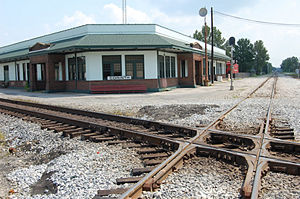
1. Frederick Boller – 113th Illinois Volunteer Infantry
2. Emory Bacon – 113th Illinois Volunteer Infantry
3. Arad Cady – 113th Illinois Volunteer Infantry
4. Diedrich Grote – 113th Illinois Volunteer Infantry
5. Nathaniel Sayles – 113th Illinois Volunteer Infantry
Marietta National Cemetery in Marietta, Georgia
1. Silas Sutherland – 52nd Regiment of Illinois Infantry
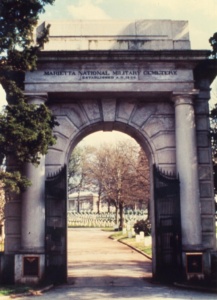
During the Civil War, forces under the command of General William Tecumseh Sherman moved in and occupied the town of Marietta, Georgia. For the next five months, federal troops held the city under siege. In November 1864, troops commanded by Union General Hugh Kilpatrick set the town on fire before embarking on their infamous “March to the Sea.”
Originally known as the “Marietta and Atlanta National Cemetery”, the Marietta National Cemetery was established in 1866 to provide a suitable resting place for the nearly 10,000 Union dead from Sherman’s Atlanta Campaign. Henry Cole, a local merchant who remained loyal to the Union throughout the war, offered land for a burial ground for both Union and Confederate dead. A subsequent purchase of additional acreage in 1870 brought the cemetery to its present size of a little over 23 acres.
Jefferson Barracks National Cemetery in Saint Louis County, Missouri
1. Frederick Homeyer – 113th Illinois Volunteer Infantry
2. Edwin. S. Kemp – 113th Illinois Volunteer Infantry
3. Louis Thies – 113th Illinois Volunteer Infantry

Jefferson Barracks, one of the National Cemetery Administration’s oldest interment sites, has served as a burial place for soldiers from all wars. The original military post was built south of St. Louis, Mo., on the banks of the Mississippi River to replace Fort Bellefontaine. Selected for its strategic geographic location, the post was opened in 1826. Jefferson Barracks became the army’s first permanent base west of the Mississippi River. By the 1840s, it was the largest military establishment in the United States. During the Civil War, Jefferson Barracks served as a training post for the Union Army. There was also a hospital at the post for the Union army’s sick and wounded.
Jefferson Barracks was formally established as a national cemetery in 1866 by passage of a joint resolution. The Civil War initiated the beginnings of a formal network of military cemeteries. The old cemetery contains approximately 20,000 gravesites, including more than 1,000 Confederate dead. During this era, Union dead were interred in sections by state, as far as that could be determined, including: 7,536 Whites, 1,067 African Americans, 1,010 Confederate POWs, and 556 “not of military service.”
- Corinth National Cemetery
